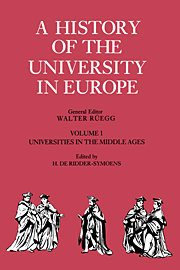Book contents
- Frontmatter
- Contents
- List of maps
- Contributors and editors
- Reader's guide
- Bibliographical abbreviations used in notes
- FOREWORD
- Acknowledgements
- PART I THEMES AND PATTERNS
- PART II STRUCTURES
- CHAPTER 3 RELATIONS WITH AUTHORITY
- CHAPTER 4 MANAGEMENT AND RESOURCES
- CHAPTER 5 TEACHERS
- PART III STUDENTS
- PART IV LEARNING
- THE FACULTY OF ARTS
- EPILOGUE
- Editors' note on the indexes
- Name index
- Geographical and subject index
CHAPTER 5 - TEACHERS
- Frontmatter
- Contents
- List of maps
- Contributors and editors
- Reader's guide
- Bibliographical abbreviations used in notes
- FOREWORD
- Acknowledgements
- PART I THEMES AND PATTERNS
- PART II STRUCTURES
- CHAPTER 3 RELATIONS WITH AUTHORITY
- CHAPTER 4 MANAGEMENT AND RESOURCES
- CHAPTER 5 TEACHERS
- PART III STUDENTS
- PART IV LEARNING
- THE FACULTY OF ARTS
- EPILOGUE
- Editors' note on the indexes
- Name index
- Geographical and subject index
Summary
It is self-evident that no university or school can exist without teachers. If a schooling differs from an apprenticeship, which is essentially practical, or from tutoring, which is in principle individual, it is because there is a teacher whose role involves him addressing himself collectively, as it were, to a given number of pupils. It is likewise the existence of a teacher that allows us to distinguish a school, even at the higher level, from the other cultural institutions familiar to the Middle Ages, such as the monastic scriptoria, the ecclesiastical or princely chancelleries or courts, academies, and so on, which tended to depend upon exchange between equals. Yet the fact that the function of teacher plainly existed in all historical periods should not be taken as an excuse for anachronism. The words describing this function have barely changed at all over the centuries, but does the teacher in medieval universities have anything in common with the teacher in present-day universities, as regards either his professional activity or his social profile – the image he receives or himself adopts?
The doctorate
The function of teacher is obviously much older than the medieval universities, as the borrowing of the key terms from classical Latin would suggest: magister (master), doctor (doctor), and professor (professor). Although these three terms were not employed indiscriminately, they began by having a similar meaning, with the idea of teaching being associated with that of excellence in a given domain. It is this second aspect, in fact, which was most emphasized in the Middle Ages. A master or doctor could teach, but this was not indispensable.
- Type
- Chapter
- Information
- A History of the University in Europe , pp. 144 - 168Publisher: Cambridge University PressPrint publication year: 1991
- 1
- Cited by

